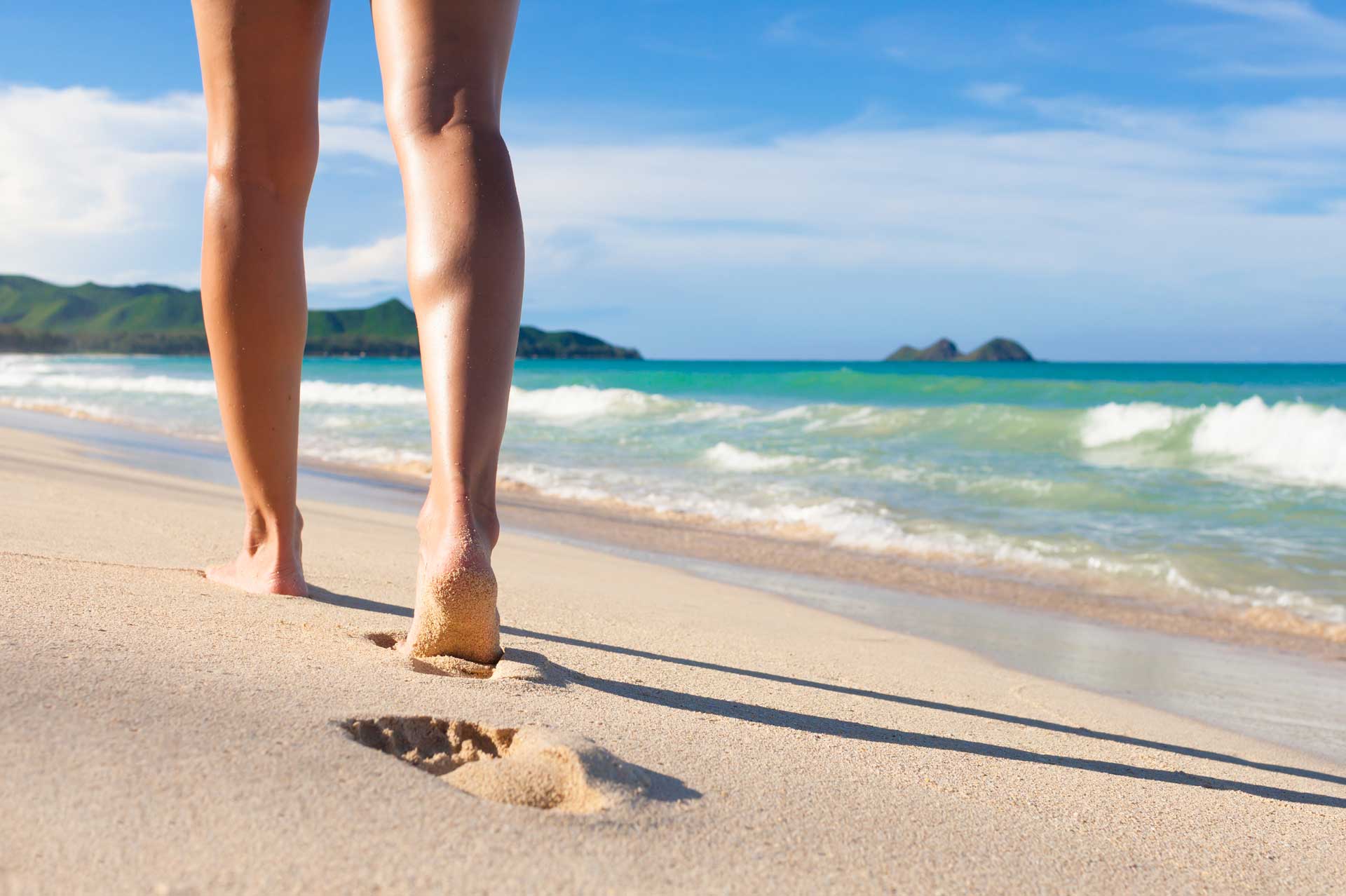- You have no items in your shopping cart
- Subtotal: $0.00
Beach walking is a relaxing way to sneak in some exercise while you’re on vacation or holiday or simply enjoying a beach day. Remember to warm up and wear the right shoes if you’re walking long distances and stick to the hard-packed sand to avoid injury if you’re a beginner beach walker.
If you’re unsure whether beach walking is a safe option for you, consult your doctor to get cleared for exercise. If you have any joint issues or chronic pain in your feet, knees, hips, or lower back, or if you have diabetes, beach walking could place additional stress on these regions.
But generally speaking, a leisurely walk on the beach is a suitable activity for most age groups and abilities to enjoy.
It’s no secret that walking is a great form of exercise for adults of all ages to maintain a physically active lifestyle. In fact, research has shown that walking one to two hours per day supports longevity and vitality as we age.
Beautiful Beach Cover Ups For Women
-
Product on sale
 Ladies Crochet Tassel Hollow Out Beach Bikini Cover Ups GreenOriginal price was: $32.00.$28.00Current price is: $28.00.
Ladies Crochet Tassel Hollow Out Beach Bikini Cover Ups GreenOriginal price was: $32.00.$28.00Current price is: $28.00. -
Product on sale
 Womens Crochet Tassel Hollow Out Beach Bikini Cover Ups RoseOriginal price was: $32.00.$28.00Current price is: $28.00.
Womens Crochet Tassel Hollow Out Beach Bikini Cover Ups RoseOriginal price was: $32.00.$28.00Current price is: $28.00. -
Product on sale
 Womens Crochet Tassel Hollow Out Beach Bikini Cover Ups WhiteOriginal price was: $32.00.$28.00Current price is: $28.00.
Womens Crochet Tassel Hollow Out Beach Bikini Cover Ups WhiteOriginal price was: $32.00.$28.00Current price is: $28.00. -
Product on sale
 Womens Crochet Tassel Hollow Out Beach Bikini Cover Ups BlackOriginal price was: $32.00.$28.00Current price is: $28.00.
Womens Crochet Tassel Hollow Out Beach Bikini Cover Ups BlackOriginal price was: $32.00.$28.00Current price is: $28.00. -
Product on sale
 Lady Crochet Tassel Hollow Out Beach Bikini Cover Ups OrangeOriginal price was: $32.00.$28.00Current price is: $28.00.
Lady Crochet Tassel Hollow Out Beach Bikini Cover Ups OrangeOriginal price was: $32.00.$28.00Current price is: $28.00. -
Product on sale
 Womens Crochet Tassel Hollow Out Beach Bikini Cover Ups PinkOriginal price was: $32.00.$28.00Current price is: $28.00.
Womens Crochet Tassel Hollow Out Beach Bikini Cover Ups PinkOriginal price was: $32.00.$28.00Current price is: $28.00. -
Product on sale
 Womens Crochet Tassel Hollow Out Beach Bikini Cover Ups BlueOriginal price was: $32.00.$28.00Current price is: $28.00.
Womens Crochet Tassel Hollow Out Beach Bikini Cover Ups BlueOriginal price was: $32.00.$28.00Current price is: $28.00. -
Product on sale
 Swimsuit Cover Ups Sexy Pullover Tops RoseOriginal price was: $32.00.$28.00Current price is: $28.00.
Swimsuit Cover Ups Sexy Pullover Tops RoseOriginal price was: $32.00.$28.00Current price is: $28.00. -
Product on sale
 Long Sleeve Hollow Out See Through Bikini Cover UpsOriginal price was: $32.00.$28.00Current price is: $28.00.
Long Sleeve Hollow Out See Through Bikini Cover UpsOriginal price was: $32.00.$28.00Current price is: $28.00.
Health Benefits of Beach Walking
- Burn More Calories,When you traverse the soft surface of the sand, you use more energy compared to walking on harder surfaces like grass or pavement, which means you’ll burn more calories as a result.
- Strengthen Muscles,As you sink into the sand with every step you take, the extra physical effort involved to lift the foot out of the sand strengthens the muscles, joints, and tendons in the feet and ankles.
- Reduced Injury Risk,Many athletes use “sand training” to build strength and prevent injury in a number of team sports. Walking on the beach is also easier on the joints.
- Improved Mood,Outdoor activities like walking on the beach are highly restorative and give our mental health a boost, too. Research has indicated that exercising near a body of water such as a lake, river, or ocean can improve mood and even self-esteem.
Whether you savor a contemplative solo stroll by the sea or a power walk through the sand to break a sweat, beach walking is a wonderful way to clear your mind and exercise your body.
What to wear to walk on the beach
There’s nothing like a seaside escape to clear your mind and ease some stress. When you need to be in an environment that soothes you, a walk on the beach can feel like a fresh breath of air to a weary soul. The beach is also a great place to pass time with people you care about. Since the beach has unique terrain with plenty of sand and little shade, it’s important to be prepared with the right gear to have an enjoyable time. Here’s what to bring in one of your favorite beach bags to your next walk on the shores.
1. Sun Protection,Protect Yourself From the Sun
First things first, you need to be prepared for some hot weather and time under the sun without any cover. This is why it is essential to bring some type of sun protection such as a parasol or a hat so that you can have shade wherever you go. Also, sunblock is a good addition to keep your skin protected from harmful UV rays especially if you’re out for a long time.
There is no shade on a beach walk, so you’ll want to protect your skin with sunscreen. Even on a cloudy or foggy day, there’s enough UV exposure to give you a sunburn.
You’ll also want to apply lip balm to protect your lips from the sun’s harsh rays as well as the wind. Wear a walking hat or a Buff that won’t blow off easily.
Many individuals like wide-brimmed hats if they’re wearing a beautiful jersey dress. The extra protection your portable shade gives you minimizes the effect of UV rays by not having direct sunlight fall upon your skin. Have fun with experimenting with different styles of hats and you will look gorgeous and be protected for hours as you enjoy your seaside walk.
2. Bring a Couple Beach Towels
When you take a walk on the beach, it’s hard to resist taking a quick dip into the beautiful waves. Having personalized beach towels on hand will free you to be a little spontaneous while you’re at the beach. Whether you’d like to take a socially distanced swim, a beach towel gives you the option to dry off and stay covered up as you continue your walk. You can also get personalized beach towels with your name and special logo on them so you can identify your towel easily from other people’s belongings.
3. Wear Gorgeous Swimsuits
Since the water is right next to you as you take your walk, it’s natural to want to take a dip to stay cool. When you wear a swimsuit, you have the freedom to indulge in the water without worrying about damaging clothing or being too wet. Swimsuits allow you to dry off quickly as you walk even after a short time especially when the sun is very strong.
Complete your set by wearing a swimsuit cover-up that doubles as a dress or shirt that you can wear to the seaside restaurant for takeout. Pick the style of swimsuit that makes you feel the most confident such as one-pieces, tankinis, and more. It’s important to have several types to match different moods and occasions so you have the perfect look every time.
4.Bring Plenty of Hydration
Being out in the sun even for just a little bit can make you feel thirsty. However, saltwater is not an option, so you want to be sure to bring a drink with you in your beach bag. This makes sure that you can stay hydrated at your convenience about having to run back to the boardwalk or a convenience store for refreshments. Hydration is key when you want to stay healthy and not get too hot alone on the beach. It also prolongs your enjoyment of the walk because you have the refreshment you need to continue without feeling light-headed or parched. Keep your water bottle secure in handy canvas totes and beach bags that are light but have strong handles to carry extra weight. These bags also enable you to bring more than one refreshment in case you plan to stay out for many hours.
5. Carry Sandals or Other Foot Protection
A walk on the beach feels great with bare feet, but it’s important to bring some lightweight sandals in case the sand is hot on your way to the shore and when you go back to the boardwalk. Sandals such as flip flops, fashion sandals, or even a pair of water shoes can be a lifesaver when you are navigating rough terrain with seashells and driftwood. This shoe should also be light so we can easily fit in your beach bag and be toted along without any strain. If you have the correct footwear with you it’s possible to switch locations at any moment. This will be especially easy because you have brought the right items to keep your feet protected.
If you’re going to take a walk on the beach this summer, bringing these items will help you have the best time while staying protected, happy, and confident.
More Tips to Get the Most Out of Beach Walking
Savor some time unplugged in nature by silencing your phone and leaving it in your pocket while you walk. You may find that you prefer the sound of the crashing waves over your favorite workout playlist.
Walking on the beach can be enjoyed solo, with your dog, or accompanied by your partner or a friend. You might even invite the whole family to join in the fun. No matter which you decide to do, here are 11 tips for getting the most out of a beach walk.
Start on a Solid Surface
Before you set out for your walk on the beach, begin with a few minutes on the pavement or boardwalk. You can also warm up on the hard-packed sand. This will help stretch your muscles and warm up your feet and ankles before you trek through the softer sand.
Wear Appropriate Footwear
If you are going for a longer walk, you should wear proper athletic shoes or athletic sandals that will support and guide your feet. Footwear will also protect your feet from glass, metal, or sharp rocks that may be hidden in the sand.
Whether you choose shoes over sandals depends on a few factors, including your level of fitness and how long you plan to walk on the beach.
You may not want to wear your best pair of walking shoes on the beach as they are bound to get sand in them.
Walk Barefoot for Short Distances
Slip out of your walking shoes or sandals and enjoy the feeling of sand between your toes and waves lapping over your ankles as you wade through the surf. The sand will even help smooth out calluses on your feet.
However, it’s best to go barefoot for short distances only, especially if you’re new to beach walking. You can gradually add on more time as you build strength to prevent strains and injuries.
Walking barefoot for longer distances, especially in soft sand, can result in muscle and foot pain as your range of motion is extended further than normal. Barefoot beach walking for longer durations can sometimes cause plantar fasciitis, so it’s advisable to wear proper footwear if you’re going the distance
People with diabetes should not walk barefoot because they are at more risk for complications if they get a cut.
Walk on Soft Sand
Whether you wear shoes or go barefoot, walking through soft sand gives you more of a workout than walking on packed sand or even a solid surface. Think of it like climbing a hill.
Build up your strength and endurance on soft sand over the course of several days. This helps prepare your body better than going out for a long walk all on soft sand.
It’s also a good idea to keep most of your walking on the hard-packed sand near the water or a boardwalk or paved path until you’ve had a chance to train your muscles for softer sand.
Beach runners should stick to the hard sand to avoid injury.
Adjust for the Slope
You’ll discover that if you walk any distance in one direction on a beach, you have an uphill foot and a downhill foot. The foot closest to the ocean can sometimes be an inch lower (or more) than the foot closer to dry land.
This misalignment can become tiresome and send you off-kilter. It could also lead to strain and injury.
Plan your walk so that you trek a quarter of the distance in one direction, then turn around and walk back to your starting point and continue on in the other direction. This can help relieve the effects of the uneven slope.
Use the Wind
On a beach walk, you may want to begin by walking into the wind so that the wind is at your back on your return journey. That way, when you start to get tired, you’ll get an assist from the wind instead of having to fight against it.
Drink Plenty of Water
If you’re walking for more than 30 minutes, consider bringing water or know where the drinking fountains are located along the way. A sunny beach and whipping winds can cause dehydration.
You should think of replenishing with water each mile. Take along a water bottle to drink and refill at least once for longer walks.
Keep Your Eyes on the Surf
There doesn’t have to be a tsunami for ocean waves to turn deadly without warning. Sneaker waves can suddenly run far up the beach and knock you over, possibly washing you out to sea.
Large pieces of driftwood can roll in on a sneaker wave and have been known to injure or even kill unwary beach walkers.
Pay Attention to Tides
For any walk that’s longer than 30 minutes, it’s important to know whether the tide is coming in or going out.7 A seemingly wide and welcoming beach can become a tiny scrap of sand when the tide comes in.
Small streams you easily stepped across earlier could transform into deep channels with a rising tide. If you crossed an outcropping next to the surf, your way may be blocked once you’ve turned around and are on your way back.
Walking during low tide is the most ideal, especially if you’re on a longer beach walk.
Obey Beach Laws
Most ocean beaches are public,few are private beaches these areas are off-limits,some beaches forbid walking your dog,Pay attention to the signs and obey the beach’s laws.
Learn where you are welcome to walk and where you should avoid trespassing.
Anyway,enjoy beach walking workout

